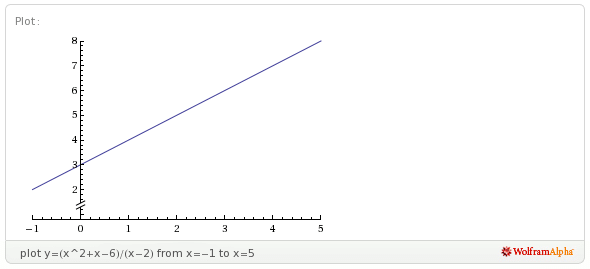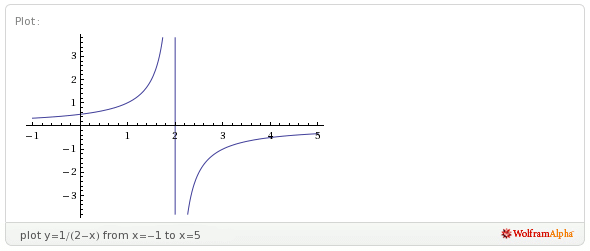Course:MATH110/Archive/2010-2011/003/Notes/Limits at a point (precise definition)
What is a limit?
We use limits to understand the behaviour of functions in the neighbourhood of some specific points. For example, consider the following example.
Example 1
Consider the functions given by
which is defined everywhere except at . We're very interested in knowing what happens to the function as it gets closer to that specific value. We could first try to plot the function near that point. If we do this for values that are getting closer to 2 from below, we get the following data:
It seems that the function is getting bigger and bigger as the values gets closer to (from below); whereas the function seems to get closer and closer to the number . But how to make sure of that intuition?
Informally, we say that the number is the limit of the function as approaches the point if the values of become arbitrarily close to the number for values of sufficiently close to .
We should be careful to see if we're approaching the function from the left or from the right, as it might yield different results. The key issue and motivation behind this more precise definition is to make sense of the arbitrarily close and sufficiently close as written above. So, say you want to check that function as above does admit as its limit as approaches ; then being arbitrarily close means that the difference between and should become as small as I want if I'm close enough to . We'll write this:
If for every positive number (think of it as being small, it's the one encoding the arbitrarily close) we can find another positive number such that
for every between and , then we'll agree to say that the limit of the function as approaches is . Since we only look at values of that are less than , this is actually a limit on the left. For the limit on the right, with values of just above , we would look at values of between and .
For instance, if we chose the value , we can find that works as all the values of between and (not included) have their values no further away from than .
Precise definitions
We're ready now to write this more formally and more precisely. Let be a function, call the number that is the limit and let the point at which we're looking be .
- We'll say that admits the number as its limit on the left as approaches if for every positive number , there exists a positive number (which might change as you change the value of ) such that:
- for all the values of that are between and (in other words: ). And we'll write this as:
- We'll say is the limit on the right as approaches if for every positive number , there exists a positive number (which might change as you change the value of ) such that:
- for all the values of that are between and (in other words: ). And we'll write this as:
- Finally, we'll say that the number is the limit as approaches if it is both the limit on the left and on the right.
Example 2 (a function that admits a limit)
Let's get back to the second function of the first example above and test our definitions.
That function should at least admit as a limit on the left, according to the data shown in the table. How do we show this? Let's pick a small positive value (you think of one, I think of one) we'll call it . We want to make sure the values of get very close to , so we have to look at
For values of less than , the number will be negative, hence applying the absolute value yields:
So we found that
is equivalent to
(for values of less than only) or in other words:
This shows that we can let be exactly the same as and this proves that
The fact that here can be observed from the above table. Indeed, we can see there that in order to be say close to the value , we need to be close to . The first is the and the second one is the .
Now in the case of the limit on the right, that is, for values of larger than , we can reuse a lot of our work. We still have that:
but since now values are larger than we have that
Hence, we find that:
This means that once again, we can let and the above shows that
Since both limits on the left and on the right are the same, we can conclude that the limit of the function as it approaches is 5.
We can observe this if we plot the function:

As you can see, it is as if the function takes the value at the point (the hole is so small, you can't see it). It is also interesting to see the graph looks like a straight line. Is it really?
Example 3 (a function that does not admit a limit)
Let's now study function from example 1. It seems that on the left, the functions grows to infinity as it approaches . Can we show this?
We could show for example that whatever value you pick, the values of will become larger than that number if we're close enough to . So, we want for any value (that could be very big). We can see that:
if (otherwise, the inequality flips sides), but that's exactly when , so we're good since we said we were looking at what's going on on the left. Let's continue:
- Failed to parse (syntax error): {\displaystyle 1 > M(2-x) \iff 1 >2M - Mx }
again, we can divide by without flipping the sides of the inequality if we assume that is positive.
So what does this say? It says for example that if you want Failed to parse (syntax error): {\displaystyle f(x) > 1000}
, then simply let
In other words, we can precisely say how close to you have to take your values of to have the values of be as large as you want. This shows that the function does not admit a limit as it approaches .
Now, what about the other side? What if we take values of larger than 2? We could see that the values of the functions were getting larger because we were dividing by a very small and positive number. If now is larger than , then the value of will be a small but negative number. So we get the same effect of getting a large number because we're dividing by a small number, but this time the whole thing becomes negative. Can we check that intuition more precisely?
Say now that is a very large negative number (think: ). We claim the function will become even more negative that this if we get close enough to . So we want to know when is . We get:
(since is negative, multiplying by this flips the inequality). And if we continue we get that:
(again, remember that is a negative number, so dividing by it flips the inequalities again).
So what does this say? It says for example that if you want Failed to parse (syntax error): {\displaystyle f(x) < -1000} , then simply let
In other words, the closer we get to (from the right), the more the values of will get closer to . This clearly shows that the function does not admit a limit on the right either.
Let's check all this by looking at the graph of the function:

We can observe that at (the vertical blue line) the function explodes to positive infinity on the left and negative infinity on the right. We call this behaviour a vertical asymptote.
Related examples and problems
This all connects very well in the textbook with section 2.2. Do problems 1, 2, 3, 4, 5, 6, 7, 8, 9, 10, 11, 15, 16, 23, 24, 25, 30, 31, 32. Remember you're by far not the only one working on these problems, if you're stuck or would like to discuss your work, use the wiki. You could ask your group or everyone using the Math Forum page.































































































